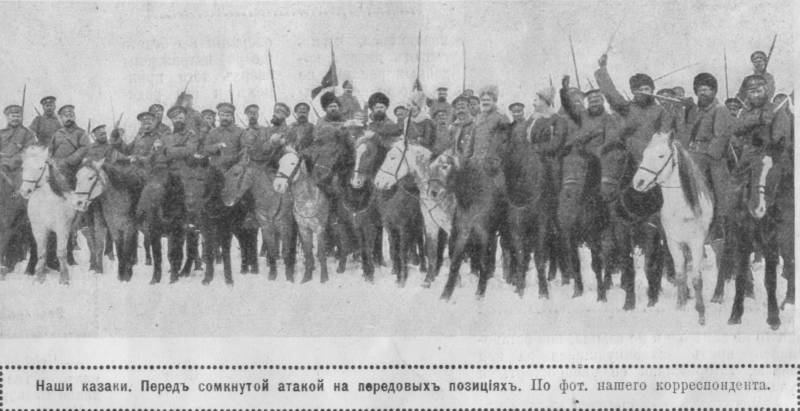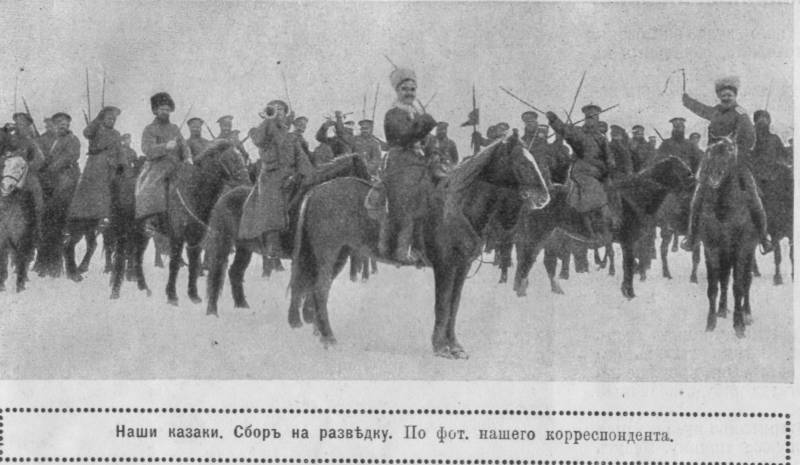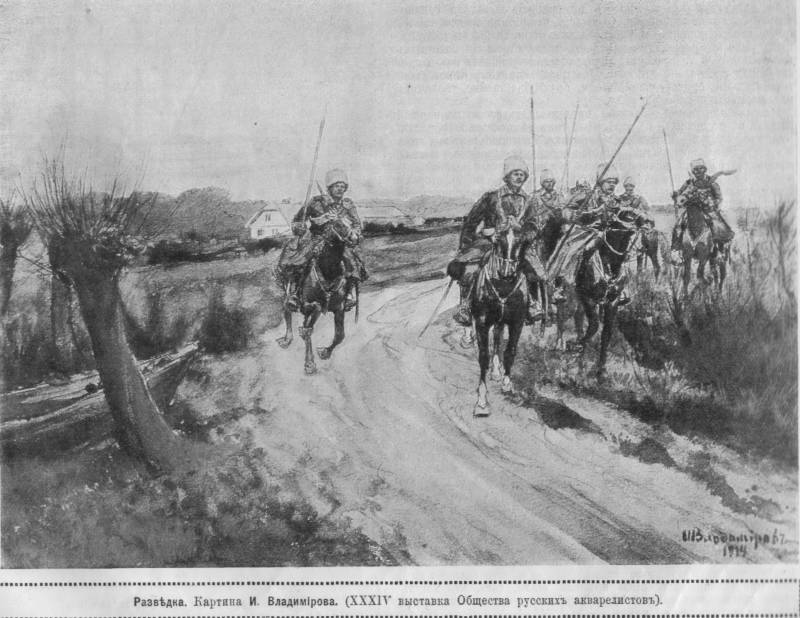Surprise as a success factor for horse attack
Surprise attack
The surprise of a horse attack is also an important factor in its success. So, F. A. Keller, doubting the success of a cavalry attack, previously detected by the enemy, called surprise as an important prerequisite for the success of a cavalry attack. The general noted that he did not believe in the success of attacks conducted in open areas, since the cavalry attack detected by the enemy infantry or artillery would not reach the attacked units, or would be so upset that it would not be effective. After all, in 3 minutes, necessary for cavalry to pass 2 km, the nerves of any infantry will calm down, and then, observing the devastating effect of their fire on the speeding cavalry, even the worst infantry will be imbued with confidence and calmness. Conversely, undoubted success is promised by a sudden attack by cavalry - it can confuse the best and most resilient infantry, and, regardless of the number of the latter, lead to complete breakdown and loss of combat capability. But for this the primary prerequisite is the presence of cavalry on the battlefield, the ability of the cavalry to "hang" over the enemy, hiding from the eyes of the latter, the ability to assess the situation, choose the right minute - and without fear of loss, take advantage of it (Keller F.A. A few cavalry questions. Issue 2. SPb., 1910. C. 5.). AND story Many of the cavalry attacks, which we mentioned earlier, having written the corresponding articles in the Military Review, fully confirm this opinion.
It was at Nezviski
So, surprise and stunning for the enemy was the 26 horse attack of February 1915 near the villages. Nezaviski, where the result achieved by eight dozen Cossacks, can be considered in the literal sense of the word amazing.
24 February, 1915, part of the 1-th Don Cossack Division, took the heights, commanders of the villages of Harasimov and Nezviski (on the Dniester, near Kolomyia) and entrenched in the snow. In the morning of 26, a fierce snowstorm rose. The temperature dropped even more. A ferocious wind blew directly into the face of the Austrians. Before sunset the blizzard subsided a bit and thick chains of Austrian infantry appeared from the village of Nezviski. An accurate fire 7 th Don Cossack battery army foreman Ivanov stopped the attack. From six o'clock in the evening the blizzard blew out with a new force, and, to prevent the Cossacks from freezing, parts of the 10 and 13 of the Don Cossack regiments were taken to the village of Isakov for the night. The liquid Cossack outposts remained against the Austrians, on the main line, on the highway leading from Kolomyia, there was a company of the 5 Infantry Regiment. The snowstorm was so strong that the trenches were completely covered in snow. The rifles fell asleep with snow, the shutters did not slide, and in order to fire a shot, one had to wipe the bolt and the box before it and warm the bolt spring. The snow was so deep that people fell knee-deep and sometimes waist-deep. It seemed that the attacks of any of the opponents at the moment are completely excluded.
But in the ninth hour of the evening rare single shots rang out, and then the company of shooters began to move away from the trenches. The sentinel men reported that Austrians were attacking them with thick chains.
The night was in full swing, the frost was growing stronger and stronger, and the blizzard was blowing, not stopping. Just at that moment, the 5-th hundred 10-th Don Cossack regiment of the military foreman D. Ye. Turumerezova, who succeeded the hundred, who was at the outposts, approached the ruins of the distillery near the village of Nezviski. By order of the head of the station - the commander of the 10 Don Cossack Regiment - a hundred, walking in a column of three, turned left, crumbled into lava and went on the attack with a shout.
The movement was carried out at the most at a trot and in some places an awkward gallop - deep snow did not allow to go fast. Horses fell through the belly in snow drifts. However, the kind of riders on gray tall horses, boldly marching towards the numerous chains of Austrians, was so impressive that the Russian infantry shouted “Hurray!” To the Cossacks. The advanced Austrians began to surrender (some were crippled), and the rear chains, in panic and terror, rushed back to Nezvisku. 80 Cossacks and 126 shooters in five minutes solved the case. The outcome of the attack was about two hundred dead and wounded (who froze to death on the field that night) and about two hundred captured Hungarians captured by the Cossacks. The sight of the prisoners was terrible. Half-frozen, blinded by a snowstorm, with hands without gloves, but only in woolen mitts, with rifles hammered out of which it was impossible to shoot, these people cried from the cold and cursed the authorities, who sent them towards the frosty blizzard and the Russian Cossacks. But what commander could have imagined that an attack would be met with a counterattack in the equestrian system?
The DKP-10 military register recorded the occurrence of 26 on February at the village of 6 of Austrian companies, the 5 counterattack of the hundreds and the capture of 176 people in the 2 officers of the 65 of the Hungarian infantry regiment and 29 of the special battalion. And the military sergeant D. E. Torumerezov became the knight of St. George weapons for the fact that in this battle with deep snow and a strong blizzard attacked hundreds of advancing Austrians in the equestrian ranks, knocked down the enemy and captured the 122 man.
The very view of the equestrian unit going to the attack by the deployed system acted on the enemy morally so strongly that the shooting of the latter became mechanical and not marked.
Khmelnik
During the October pursuit of the Austro-German forces behind the Vistula in 1914, near the town of Khmelniki, part of the 1-th Don Cossack Division caught up with the rearguard of the Austrians and the backward wagons coming out of Khmielniki. Obozi covered the infantry battalion, and the cavalry was ahead. The squad had 12 guns.
The commander of the 10 Don Cossack Regiment, Colonel P. N. Krasnov, rushed at the head of five hundreds, three lines in line, to attack. Hundreds were galloping on the tail of carts. It was evident that the driver's horses were tugging at the horses with shouts and cries of horror, as the wagons fell and overturned. The Hungarian cavalry stopped, and 12 opydy opened frequent shrapnel attacks on the attacking Cossacks.
Having passed the village, the Cossacks stumbled upon a wide and deep ravine with so steep banks that it was possible to overcome it only with a step. On the other side of the ravine stood a battalion of cover, which opened frequent fire on the Cossacks. Seeing this, the commander of the regiment commanded: - “The regiment was planned back - to hide behind the houses of the village, to cover the waste with machine guns”.
Well-trained Cossacks, just three months ago, who brilliantly passed the regimental review, turned as one and disappeared behind the village. The centurion Dubovsky and the primitive Belyaev rolled out their machine guns and forced the battalion to lie down. Confusion occurred in the ranks of the latter. The commander of the regiment took advantage of this - in order to remove the equestrian unit that had already reached 600-700 steps into a deep ravine behind the village, there is a hurry for the Cossacks and to launch the right offensive on foot - on the same transports.
The Austrian cavalry remained an idle spectator of everything that was happening, and when she noticed the advance of dismounted Cossacks, supported by the remarkably well-aimed fire of 7 of the Don Battery of troop officer M. M. Ivanov, she turned and began to retreat.
The HDD 1 DKAD contains the following lines: “On October 22, the Don Cossack Division was rushing 1 towards the Khmilnyk highway, which was formed between the Guards units. Chmielnik has an avant-garde 7 battery and started a battle with the battalion to cover the enemy's carts. Soon, the 6 battery came up to her position from the main forces. With their well-aimed fire, the batteries scattered and almost destroyed the cover and smashed a wagon train, part of which is in the 1 number of the car, several dozen carts and charging boxes were thrown by the enemy.
The Cossacks, scattering the enemy’s infantry covering the carts in the nearby forests, mounted their horses again and rushed to Khmilniki. 4 and 2 are hundreds of 10 Don Cossack Regiments, and behind them the entire 15 Don Cossack Regiment broke into Khmelnik and captured transports, about a hundred prisoners and numerous charging boxes.
The losses of the 10 Don Cossack Regiment during an unsuccessful cavalry attack are two lightly wounded Cossack shrapnel bullets. So unsuccessful was the fire of the Austrian batteries and infantry - under the threat of horse attack.
To be continued ...



Information